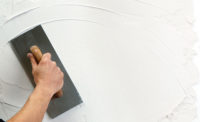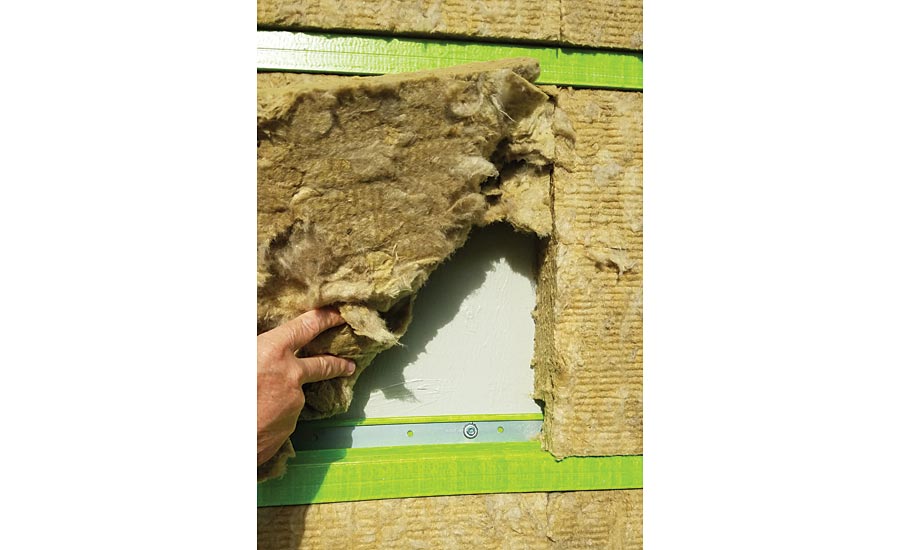Stucco Applications on CI Systems
Stucco Opportunities Within the International Energy Conservation Code.


Table 1. Excerpt from Chapter 26-Plastics, 2018 IBC Credit: DRJ Engineering



Six millimeter rainscreen being applied to fiberglass girders running horizontally. Courtesy of Diversified Plastering LLC, Houston.

Note the liquid-applied air/water barrier on top of sheathing, with Z-girts (green) attached.


Finished welded wire lath over rainscreen, with accessories applied at jamb and base of wall.

Finished wall with welded wire lath running vertically; perpendicular to attached Z-girders.

Santa Maria Church Addition- Houston, TX – work performed by Diversified Plastering, LLC










When it was first drafted in 2000, the International Energy Conservation Code established a model code for states and municipal governments in the United States to set minimum design and construction requirements for energy efficiency. There are many design paths to accomplish the IECC code requirements, including both prescriptive-based, as well as performance-based design initiatives to elevate energy efficiency.
While these codes focused on commercial construction, an alternative for one- and two-family dwellings—the International Residential Code—provides prescriptive energy provisions that can be easily implemented and are consistent with IECC provisions.
Many new cladding systems have evolved from these new energy standards, with the concept of continuous insulation being one of the most prevalent today. Continuous insulation, also known as CI, is defined by ASHRAE 90.1 as “an insulation that is continuous across all structural members without thermal bridges other than fasteners and service openings. It is installed on the interior, exterior, or is integral to any opaque surface of the building envelope.” (ASHRAE def. Dec 14, 2016).
However, the growing prevalence of continuous insulation has created new challenges for the plastering industry because applying the conventional ASTM standards of C-1063 (Lathing) and C-926 (Plastering) to these CI Systems takes lathing and accessories far beyond their intended scope, as defined in ASTM C-1063 –Standard Specification for Installation of Lathing and Furring to Receive Interior and Exterior Portland Cement-Based Plaster. Without prescriptive requirements to work with, manufacturers have been forced to innovate their own approaches to these CI-stucco systems and have the local Authority Having Jurisdiction review and approve the proposed systems.
Chapter 26 - Plastics of International Building Code, Section 2603 has addressed the issue of cladding attachment through foam plastics, including thicknesses allowed, and fastener size and spacing, so not to deflect the cantilevered fasteners due to overweight claddings. (A portion of those are shown in Table 1.)
The engineering formulas used to build the data in the table shown above comes from a paper developed by the Foam Sheathing Coalition’s Tech Matters, “Guide to Attaching Exterior Wall Coverings Through Wood or Steel Framing,” published December 2011. This paper builds its findings on data from previous published loading information found in:
- American Society of Civil Engineering’s ASCE 07-Table C-3-1 Minimum Design Dead Loads
- American Iron & Steel Institute’s AISI S100 Lateral Connection Strength - Steel Application
- National Design Specifications for Wood - American Forest & Paper Association
- General Dowel Equations for Calculating Lateral Connection Values - American Forest & Paper Association
The illustration (right) shows attachment strategies for Foam Plastic Insulation Systems, or FPIS.
Worthy of note is the fact that IBC’s Chapter 26-Plastics, Table 2603 attachment guidance only includes foam plastics like expanded and extruded polystyrene, and polyisocyanuate. Mineral wool, also referred to stone wool, is not included in that list.
With all the loading and fastening requirements determined, there is still the detailing of the plaster returns into window and door openings to consider. The most current version of ASTM C-1063-19 – Standard Specification for Installation of Lathing and Furring to Receive Interior and Exterior Portland Cement-Based Plaster provides very little direction. However, Section 7.4.3 Lathing Accessory Water Management Requirements states, “Where a defined drainage space is provided over the water-resistive barrier under lath and cement plaster, the ground dimension of lathing accessories with solid attachment flanges installed behind the water-resistive barrier and defined drainage space to facilitate drainage, such as weep screeds, designated drainage screeds, expansion joints and drainage flashings, shall accommodate the defined drainage screeds, expansion joints and drainage flashings, shall accommodate the defined drainage space dimension and specified cement plaster thickness.”
This statement insinuates the need for larger stucco accessories to accommodate the entire thickness of the CI stucco system. Today, there are very few mass-produced casing beads, or weep screeds, control or expansion joints wide enough to accommodate the insulation and the stucco cladding combined. Even if there were, most building owners are not attracted to large galvanized dead/jamb details that are prone to scratches and rusting. Some components have been designed to “return” the stucco back into the window and door openings, where NFPA 285 Fire Promulgation Testing is required on certain types of fire-rated building types. But their use has been limited until now. (See illustration from ClarkDietrich, Figure 2.)
So, what we have seen emerge is CI stucco systems applied to metal laths, over WRB or 6 millimeter rainscreen, (with or without) an exterior sheathing attached to horizontally attached Z-girders, and foam insulation or mineral wool insulation sandwiched between the Z-girts. In many cases, innovative fiberglass-covered metal girts are being specified to mitigate thermal transmission, with details on how to fasten the lathing systems to their fiberglass surface, as seen on this project (see Figure 3, Smart CI).
In this application, the sheathing was below the Z-girts and mineral wool with a fluid-applied air/water barrier on top. The detailing of this type of system still requires the contractor to finish the plaster around windows, doors, openings, base of wall, and soffit transitions. In this example, the author is aware of only one metal lath manufacturer that has a third-party test report to attach the (welded wire) lath vertically to the horizontal Z-girts, thereby maintaining the “perpendicular to the framing” requirement found in ASTM C-1063, Section 7.10.1.3, which states “Lath shall be installed with the long dimension at right angles to the framing members, unless otherwise specified.” The photos above show this system going into place during a recent project at Santa Maria Church in Houston.
Emerging changes in test documentation include updates to Foam Sheathing Coalition information are found at www.contiuiousinsulation.org. The most significant change are separation in requirements for Steel and Wood framing systems, and furring applied both vertically and horizontally in Foam Plastic Insulated Sheathing. A comprehensive report was written by DRJ Engineering Services, Report #DRR 1707-02, issued 8/18/14, updated 5/18/19 that outlines various FPIS systems, including associated engineering data.
In closing, the evolution of these CI Stucco systems will likely not become codified, as many performance-based designs are likely to emerge, each with different approaches to how the cladding is installed. With that in mind, it is important for project teams to work closely with the designer of record to secure approval by all contracted parties and, ultimately, the authority having jurisdiction at the local building code department.
Looking for a reprint of this article?
From high-res PDFs to custom plaques, order your copy today!
















